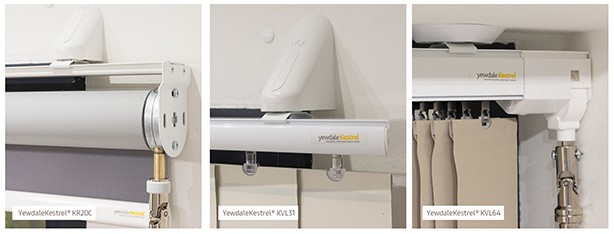The concept of installing window blinds in a mental health care facility, where the potential risk of self-harm or suicide is already at a heightened level, may seem counter-intuitive on the face of it. However, anti-ligature blinds have been painstakingly developed to ensure the risk of a lethal ligature point is severely decreased, thwarting many attempts of self-harm.
Yewdale supply roller blinds and vertical blinds with a choice of mechanisms within our YewdaleKestrel® range. These are known as the KR20 Sidewinder, KR20C crank operated blind and the KR20S spring operated roller blind and KVL31 premium wand vertical blind.
These blinds provide shade and assist with sleep and privacy whilst remaining anti-ligature and safe. The emphasis on safety and quality for these systems is never lost on Yewdale. According to the Care Quality Commission, three-quarters of people who kill themselves on a psychiatric ward do so by hanging or strangulation.
The very nature of some mental illnesses being treated within these environments is itself a factor which leads to long periods of isolation, combined with high-functioning intelligence and tenacious behavioural tendencies allows some patients to find ligature points in places and items one would never have considered as a risk before.
Ordinary daily items like floss can be tied to a door as an attempted ligature point, bed sheets and clothing tied to create a noose and (as previously reported here), the ripping out of hardwired fire alarms and their wires from the ceiling to provoke electrocution or to form a ligature point. The robustness and quality levels of anything that goes into those environments, therefore, need to be made to the highest standards.
YewdaleKestrel® anti-ligature window blinds are among the most used systems in the industry. This can be attributed to the simplicity and ease-of-use of these systems. If they are pulled down, they are reattached in seconds.

On the face of it, the blinds look like any other blind, lending a sense of normality that is conducive to the welfare and recovery of the patient. However, when excessive weight is applied to the blind, the blind will separate from magnetic brackets, rendering the blind useless as a ligature point.
Yet, the blind can simply be offered back up to the magnets and it will reattach and continue to function as a blind. Staff are also able to remove the blind from the room on a patient-by-patient basis, depending on the circumstances. By being modular in this way, all rooms can potentially come fully equipped with anti-ligature systems, and then they can be removed to adapt a room to suit the service user, instead of having specified rooms and spaces which may or may not always be applicable to the needs of the user and therefore run the risk of remaining vacant.
Aside from the magnetic brackets, these blinds look and function much the same as our standard roller blind and vertical blinds. The operation mechanisms are still of the highest quality and function perfectly time and time again. Combined with our choice of fabric, which feature Biosafe® anti-microbial accreditations, fire retardancy, water resistance and more, these blinds can be installed – and survive – in nearly any environment.
YewdaleKestrel® blinds can only be installed by an approved, qualified professional installer who must attend a YewdaleKestrel® anti-ligature course. This ensures high standards are maintained, making these blinds as safe as possible.
To find out more about our YewdaleKestrel® range of anti-ligature blinds, contact your Business Development Manager today!





![How to install a roller blind [Guide for blind installers]](https://d31mjrh0h6ueh4.cloudfront.net/uploads/blog/12_348_t.jpg?v=1708432751)
Leave us a comment